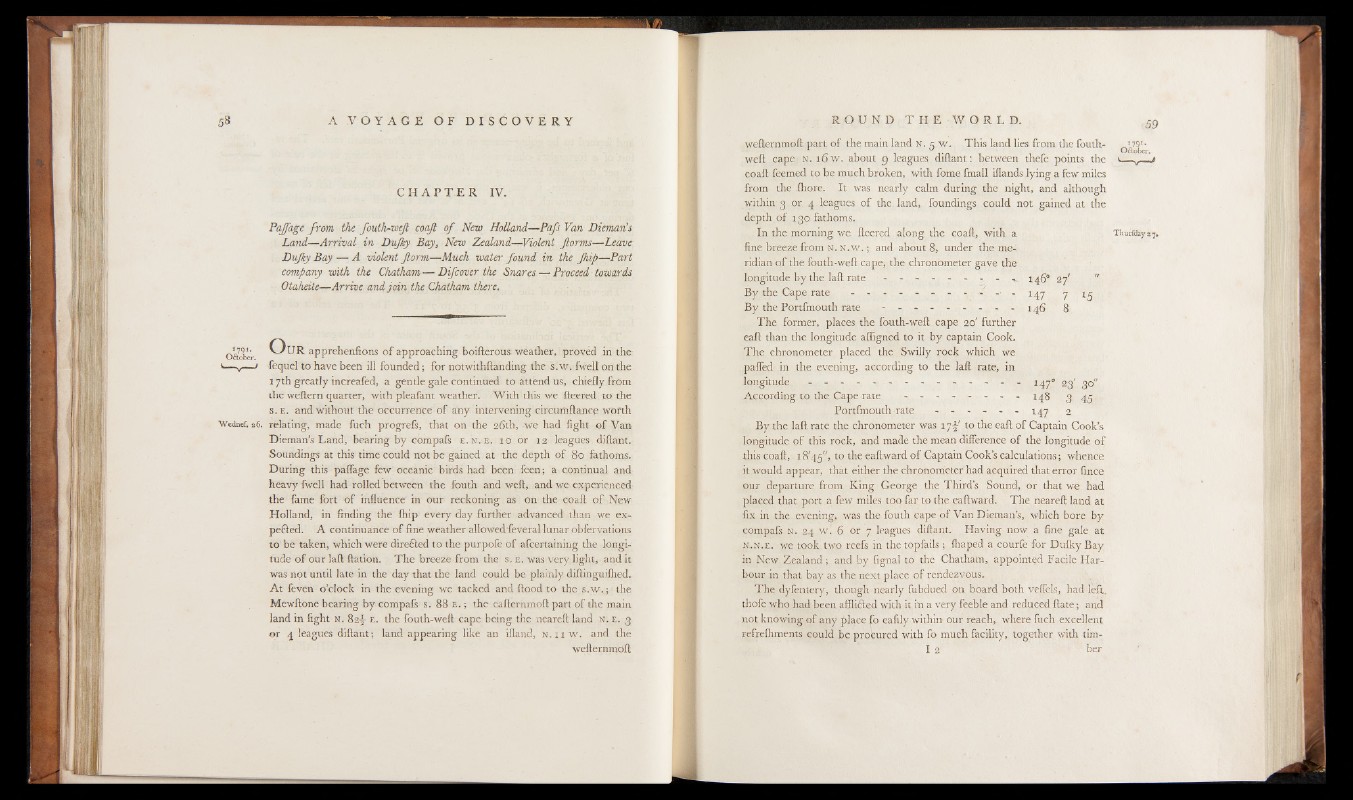
C H A P T E R IV.
Pajfage from the fouth-wef coaf o f New Holland— P ifs Van Dieman’s
Land— Arrival in Dujky Bay, New Zealand— Violent form s— Leave
Dyjky Bay — A violent fo rm — Much water foun d in the f lip — Part
company with the Chatham — Dfcover the Snares — Proceed towards
Otaheite— Arrive and jo in the Chatham there.
Ofteb'e’r ^-^UR apprehenfions o f approaching boifterous weather, proved in the
I— „— > fequel to have been ill founded; for notwithftanding the s.’w. fwell on the
17th greatly increafed, a gentle gale continued to attend us, chiefly from
the weftern quarter, with pleafant weather. With this we fleered to the
s.E. and without the occurrence o f any intervening circumftance worth
Wednef. 26. relating, made fuch progrefs, that on the 26th, we had fight of Van
Dieman’s Land, bearing by compafs e. n. e. 10 or 12 leagues diftant.
Soundings at this time could not be gained at the depth of 80 fathoms.
During this paffage few oceanic birds had been feen; a continual and
heavy fwell had rolled between the fouth and weft, and we experienced
the fame fort of influence’ in our reckoning as on the coaft o f New
Holland, in finding the fhip every day further advanced than we ex-
pefted. A continuance of fine weather allowed feveral lunar obfervations
to be taken, which were direfted to the purpofe of ascertaining the longitude
of our laft ftation. The breeze from the s. E. was very light, and it
was not until late in the day that the land could be plainly diftinguifhed.
A t feven o’clock in the evening we tacked and flood to the s.w,,; the
Mewflone bearing by compafs s. 88 e . ; the eafternmoft part of the main
land in fight n . 82-y e . the fouth-weft cape being the neareft land N. E. 3
or 4 leagues diftant; land appearing like an ifland, n. 11 w . and the
wefternmoft
wefternmoft part of the main land N. 5 w . . This land lies from the fouth- oS ,'"
weft cape N. 1 6 w. about 9 leagues diftant; between thefe points the >■ v ‘
coaft feemed to be much broken, with fome fmall iflands lying a few miles
from the Shore. It was nearly calm during the night, and although
within 3 or 4 leagues of the land, foundings could not gained at the
depth of 130 fathdms,
In the morning we fleered along the coaft, with a Thurfdays^,
fine breeze from if. N .w .; and about 8, under the meridian
of the fouth-weft cape, the chronometer gave the
longitude by the laft rate - - - - - - - - - - 146“ 27' "
By the Cape rate - - - - - - - - - 147 7 k
By the Portfmouth rate - - - - - - - - - 146 8
The former, places the fouth-weft cape 20' further
eaft than the longitude afligned to it by captain Cook.
The chronometer placed the Swilly rock which we
paffed in the evening, according to the laft rate, in
longitude - - - - - - - ........................- - 1470 23' 30"
According to the Cape rate - - - - - - - - 1 4 8 3 4 5 ’
Portfmouth rate - : - - - - - 147 2
By the laft rate the chronometer was 17A' to the eaft of Captain Cook’s
longitude of this rock, and made the mean difference o f the longitude of
this coaft, 18'45", to the eaftward o f Captain Cook’s calculations; whence
it would appear, that either the chronometer had acquired that error fince
our departure from King George the Third’s Sound, or that we had
placed that port a few miles too far to the eaftward. The neareft land at
fix in the evening, was the fouth cape of Van Dieman’s, which bore by
compafs n . 24 w . 6 or 7 leagues diftant. Having now a fine gale at
h.n .e . we took two reefs in the topfails ; fhaped a courfe for Dulky Bay
in New Zealand; and by Signal to the Chatham, appointed Facile Harbour
in that bay as the next place of rendezvous.
The dyfentery, though nearly fubdued on board both veffels, had left,
thofe who had been afflitled with it in a very feeble and reduced ftate; and
not knowing of any place fo eafily within our reach, where fuch excellent
refrelhments could be procured with fo much facility, together with tim-
I 2 her